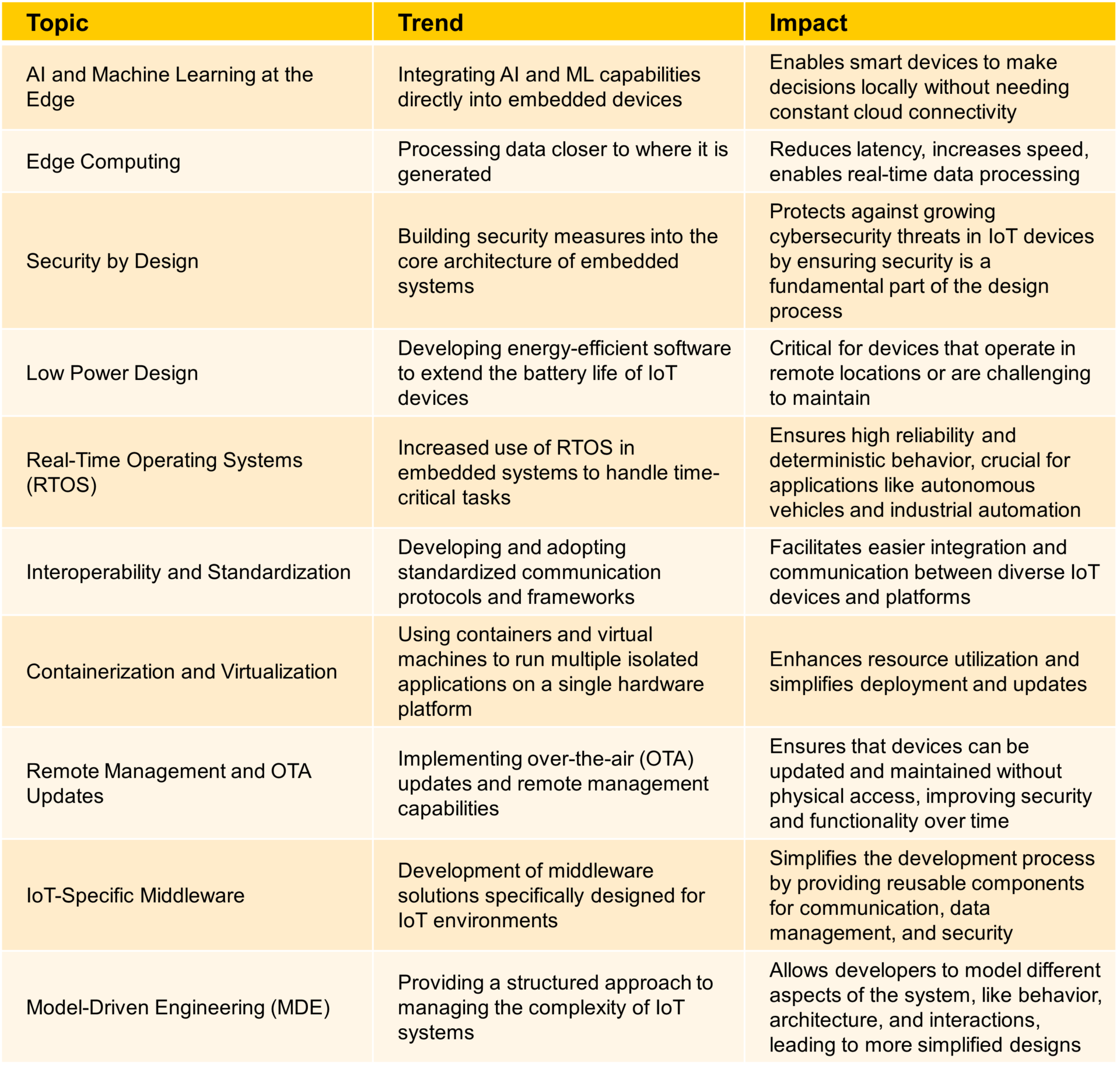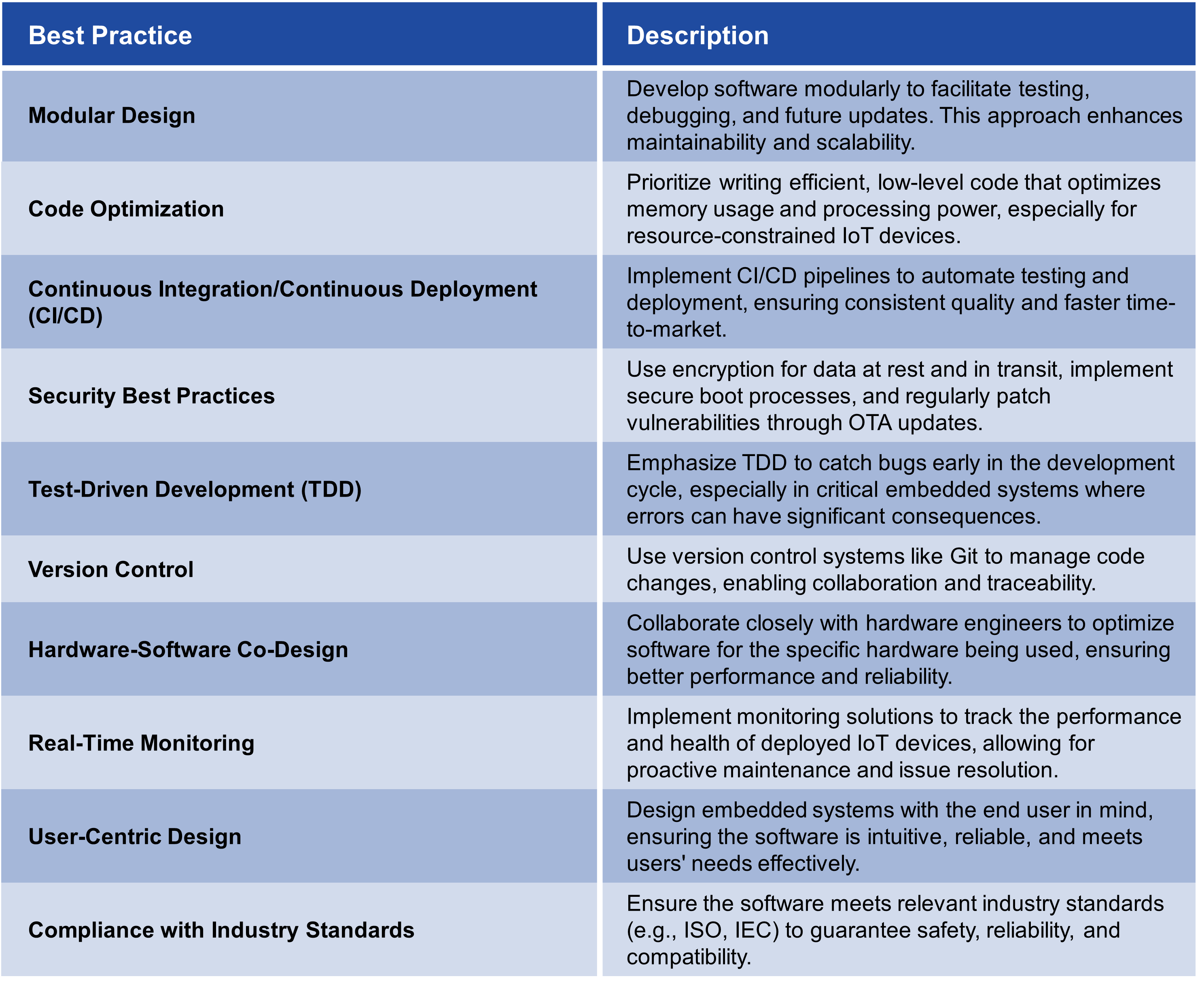The Internet of Things (IoT) is a network of devices, sensors, actuators, and other embedded systems that communicate and exchange data over the internet. IoT enables new applications and services to improve efficiency, safety, convenience, and quality of life for various domains, such as smart homes, smart cities, smart health, smart agriculture, and smart industry. Its growing popularity is undeniable, reaching $100 billion in market revenue for end-user solutions spending in 2017, with projections of $1.6 trillion by 2025.
How IoT is Changing Embedded Software Systems
IoT adds more devices and data to the network and creates new interactions and dependencies. Embedded software systems must be more adaptable, modular, and collaborative, supporting various communication protocols, data formats, and standards.
Some of the ways that IoT is changing embedded software systems are:
Monolithic to Microservices
Monolithic embedded software systems comprise a single executable that runs on a single device, performing all the functions and tasks. Microservices embedded software systems are composed of multiple, independent, and loosely coupled services that run on different devices, communicating through APIs. Monolithic systems are easier to develop and deploy but harder to modify and scale. It’s the opposite for microservices systems. In short, microservices enable greater flexibility, scalability, reusability, and faster development and deployment cycles.
For example, for roughly 100 years there were no computers in cars. Starting in the 80’s manufacturers started adding large microcontrollers to manage several functions in the car. The microcontrollers did not talk to each other. Today, a car can have over 100 microcontrollers sensing the vehicle parameters like speed and brake position, taking actions to change those parameters, such as applying the brakes and making decisions to coordinate the actions of several microcontrollers. These microcontrollers are all connected to a local network with the data available to all controllers.
The IBM Market Development & Insights team recently conducted a series of surveys recording feedback from users and hopeful users of microservices. The results showed that 88% of users and 77% of nonusers believe in the benefits offered by microservices. Additionally, 87% of users agree that the effort and expense of adoption is worth it, with 68% of nonusers believing it will be. Any challenges related to microservices adoption seemed able to be remedied with little disruption, as only less than 25% of developers, developer executives, and IT executives saw any barriers as significant.
Overall, users saw the following benefits:
- 30% higher customer satisfaction and retention
- 29% better company and customer data security
- 29% faster time to market or response time to market changes
- 28% improved application quality and performance
- 27% greater flexibility to scale resources up or down
- 26% improved employee productivity and application security
Centralized to Distributed
Centralized embedded software systems rely on a single or a few controllers that manage the devices and data. Distributed embedded software systems rely on multiple devices or nodes that cooperate and collaborate, sharing the workload and data. Distributed systems enable greater resilience, robustness, efficiency, and lower latency and bandwidth consumption.
One way to understand interoperability in a distributed system is to consider the automotive example above. As each manufacturer moved to a distributed model, they defined their own architecture and interfaces. For instance, vendors providing antilock braking systems had to build a different version of the system for each manufacturer.
Oftentimes, the software was significantly different from manufacturer to manufacturer. This made reusability difficult. It took a very significant effort for the OEMs and vendors to develop and agree on a standard architecture so that components could be more easily integrated and reused. Yet, manufacturers and vendors made proprietary modifications or extensions to the architecture in an attempt to find a competitive advantage. The result is an increase in the integration effort and a decrease in reusability.
Edge computing is one example of a distributed IT architecture that brings computation and data storage closer to the devices that use them instead of relying on a central cloud server. A simple analogy for edge computing is to think of a team of workers with the tools and skills to perform their tasks instead of sending all their work to a distant boss overseeing everything. Edge computing makes workers more independent, productive, and responsive to changing situations and demands.
In addition to its many benefits, a switch seems imminent to retain a competitive edge. According to research published by the TechTarget Data Center, it’s anticipated that 75% of enterprise-generated will be created outside of centralized data centers by 2025.
Static to Dynamic
Static embedded software systems are configured and deployed once and do not update without manual intervention. Dynamic embedded software systems can adapt to changing conditions and requirements while subject to remote monitoring and control. Dynamic systems enable greater responsiveness, agility, and functionality and are easier to maintain and manage.
Coupled with AI or “smart middleware,” self-healing is the next generation of IoT, mitigating disruptions caused by future cyberattacks. These dynamic self-correcting powers could aid in developing “smart grids” or renewable energy sources, infrastructure collaboration and stabilization, proactive approaches to cloud computing defenses, and more.
However, while AI is a popular buzz word today, it is a long way from being applied at the IoT level. Today, AI runs on huge server farms drawing gigawatts of power. Moving that down to the microcontroller is years off. Having said that, adaptive algorithms and learning algorithms that run on microcontrollers have been employed for at least 30 years and have evolved significantly during that time.
Isolated to Connected
Isolated embedded software systems operate independently and do not interact with other networks. Connected embedded software systems are part of the IoT ecosystem and can exchange data with other platforms, such as cloud computing, edge computing, fog computing, or blockchain. Connected systems enable greater integration, interoperability, intelligence, and new business models and opportunities.
One way to understand the difference between isolated and connected embedded software systems is to picture them as two different appliances in your home. An isolated system is like a toaster that only does one thing: toast bread. It doesn’t communicate with any other device or network or change its behavior based on external factors.
A connected system is like a smart refrigerator that can do many things: keep food fresh, monitor inventory, suggest recipes, order groceries online, and even play music or videos. It communicates with other devices and networks, such as your smartphone, smart speaker, or the internet, and it can adapt its behavior based on your preferences, the weather, or feedback from other users.
In today’s digital world, it’s nearly impossible to avoid connection. Likewise, by 2025, IoT deployment is expected to reach 30.9 billion connected devices.
Emerging Trends and Best Practices for Embedded Software Development in the IoT Era
In the IoT era, embedded software development is evolving rapidly to meet the demands of connected devices. Likewise, businesses must adopt new tools, techniques, and methodologies to cope with the IoT environment’s complexity and diversity, emphasizing the need for security, efficiency, and adaptability in our modern, dynamic technological landscape.
The following tables represent key emerging trends and best practices:


Oxford Can Help
IoT poses significant challenges for embedded software systems because they are designed to operate on specific hardware platforms, with limited resources, and often in real-time or safety-critical environments. Embedded software systems must deal with interoperability, scalability, security, reliability, and performance issues while meeting the end-users’ and stakeholders’ requirements and expectations.
For example, cybersecurity is significantly more difficult to manage in a distributed system. When a vulnerability is found in a non-distributed system only one device needs to be updated. In a distributed system, you might have to update thousands of devices. If it’s connected to the internet, it can be hacked.
Oxford can provide you with the right talent for your IoT project to help things progress smoothly. We know what these difficulties are and how to overcome them. We know how to develop a phased approach to get from where you are to where you want to go. We have people who have spent years in the industry thinking about and solving these problems.
Our team of experts can:
- Assess your current system architecture and identify best practices and standards for your industry and use case
- Develop or optimize your embedded software code to ensure optimal performance, scalability, security, and interoperability
- Integrate your embedded software with cloud platforms, edge devices, sensors, and other IoT components
- Test and validate your embedded software against the relevant industry standards and certification requirements
- Provide ongoing support and maintenance for your embedded software and IoT system
We know no two companies are the same, so we customize each service to fit you. We don’t want to just fix problems; we want to provide lasting solutions. Our tailored solutions, proactive recruitment, rapid response times, end-to-end support, global reach, commitment to success, and partnership-first approach set us apart from other professional services firms.
At Oxford, we’re more than just a service provider – we’re your strategic partner dedicated to your long-term success.
.svg.png)

